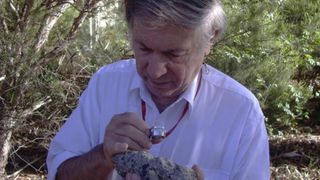Biggest Asteroid Impact Zone Found Under Australia

The scars of what may have been Earth's largest asteroid crash lie hidden deep below Australia, scientists announced.
Sometime between 300 million and 600 million years ago, a massive space rock split in two before colliding with the planet. The apocalyptic impact created two craters that together stretched more than 250 miles (400 km) across, wider than the state of Missouri, according to a new study.
"The two asteroids must each have been over 10 kilometers (6.2 miles) across — it would have been curtains for many life species on the planet at the time," Andrew Glikson, a paleoclimate scientist at Australian National University who led the study, said in a statement. [Crash! 10 Biggest Impact Craters on Earth]
You can't visit these impact sites today like you could visit Meteor Crater in Arizona. The prehistoric craters in Australia have been obscured by natural geological processes. What survives are two underground "domes" that formed when Earth's crust rebounded after the impacts, lifting up rock from the mantle below, Glikson explained.
Glikson and his colleagues found the first signs of these domes while drilling into the Earth's crust as part of a geothermal research project in the Warburton Basin in central Australia. They found that their drill cores from more than 1.25 miles (2 km) below the surface contained traces of rocks that had been melted to glass during a catastrophic impact. Then, magnetic survey data uncovered the iron- and magnesium-rich underground domes.
The researchers still don't have a full picture of the impact — they don't know when exactly the crash occurred, and they haven't found a corresponding layer of sediment that would match that of such an event.
The newfound impact zone under the Warburton Basin unseats the previously biggest-known impact crater, Vredefort crater in South Africa, which was originally more than 185 miles (300 km) across. Vredefort still reigns as the oldest impact crater ever found on Earth; it was carved out 2.02 billion years ago, scientists estimate.
Sign up for the Live Science daily newsletter now
Get the world’s most fascinating discoveries delivered straight to your inbox.
The findings were described this month in the journal Tectonophysics.
Follow Megan Gannon on Twitter. Follow us @livescience, Facebook & Google+. Original article on Live Science.

